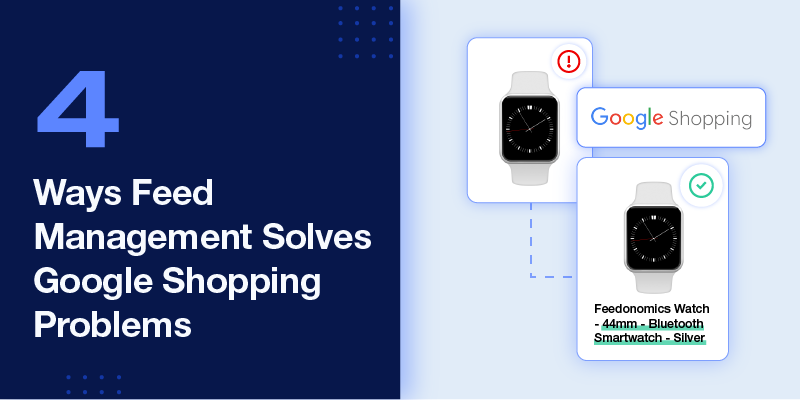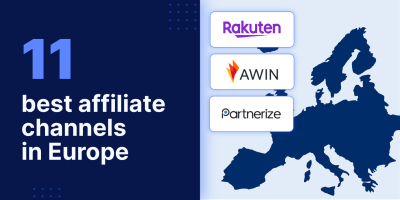Google Shopping campaigns are a powerful tool that brands and ecommerce companies use to advertise products to new and existing customers. But with millions of ecommerce websites vying for consumer attention, how can brands compete? The secret is high-quality data feed management.
Here are four ways that data feed management helps businesses achieve Google Shopping success.
1. Optimizing source data for Google Shopping ads
Nearly 60% of shoppers use Google to research a purchase. Securing the top spot in the search results is incredibly valuable (it has an average click-through-rate of 27%), but how do you give your product ads the best chance of showing up first?
When creating a Shopping feed, you must follow Google’s product data specifications to list your products, but to maximize your search relevancy and chance of conversions, you need to create high-quality product listings that go beyond the basic requirements.
The raw product data from your ecommerce platform is likely suitable for your website, but it’s probably not optimized for additional shopping channels, and transforming the data in your platform is difficult.
How a feed management solution optimizes your source data for better results
With hundreds or thousands of products, it can be tedious to optimize your catalog for Google Shopping with better product titles, granular categorization, and optional attributes. The right feed management platform allows you to optimize your data at scale without the limitations of Google Sheets or Excel. A platform like Feedonomics is built to handle catalogs with millions of products, and includes service from knowledgeable feed specialists who can implement Google Shopping best practices for you.
Here are a few ways a full-service feed management solution can elevate your listings:
- Optimize titles to include common product nouns, consistent formatting, and attributes like size, material, or color.
- Categorize products accurately so Google’s algorithm displays relevant products in search results or next to similar products.
- Fill in optional attributes to improve search relevance and performance throughout the Google network. For example, the short_title attribute is suited to mobile browsing experiences.
Mike Lindamood, owner of Lamood Big Hats, found that catalog optimizations by Feedonomics significantly improved his performance on Google Shopping.
“The optimizations Feedonomics does benefit the business a great deal with the extra sales revenue and the lower spending cost on those ads.”
With help from Feedonomics, Lindamood has increased conversions (32%) and conversion rate (6%) and decreased cost by 13%.


2. A/B testing product data for better campaigns
When you list products online, it takes some time to discover what drives clicks and conversions. Measured trial and error is a powerful and cost-effective way of gathering data to improve your selling strategy. This can be done via A/B testing, where you compare two variables side-by-side to determine which version of an ad is most effective.
You can test different product photos, descriptions, titles, and more. Google Shopping does not let you create multiple ads for the same product, so to run a test well, you need to split your catalog into random and representative groups and compare performance across them.
How a feed management solution prepares your catalog for A/B testing
The right feed management solution simplifies A/B testing by making it easy to categorize your products, divide them into test groups, and apply custom labels to each product set.

A flexible feed management platform lets you adjust your data for virtually any test. For example, you can create one test group with product titles that showcase your brand first, and another test group where your brand is listed last in the title. You can export different lifestyle images in your feed, or see if people prefer “sneaker” or “tennis shoe” in the title.
Kris Clason, Director of Client Marketing at Trellis, had his dedicated feed manager at Feedonomics prepare a client’s catalog for A/B tests. According to Clason, testing on a small scale was a great way to prepare for an eventual transition from Smart Shopping to Performance Max.
“We were able to segment our product feed in a place to allow us to test Smart Shopping versus Performance Max and be able to make optimizations to how we deliver Performance Max before having to go all in on Performance Max,” Clason said. “Proper segmentation, proper labeling, and proper attributes are required for that to happen.”

3. Resolving errors in Google Merchant Center
Like any marketplace or ad channel, Google has policies and guidelines that online merchants must follow. These guidelines include things like clearly stating your refund policy on your website, or maintaining certain standards of content in your ads. If you don’t stay up-to-date with the rules, there are consequences; item disapprovals prevent you from running ads for specific products, and account suspensions prevent you from advertising products altogether.
For the inexperienced, it’s not always clear how to resolve an error, and products may be flagged for multiple violations. A large catalog presents more potential for error, and it takes much longer to understand your data and troubleshoot issues.
How a feed management solution keeps your Google Shopping account in good standing
Some errors are inevitable, but many are prevented with proper feed management. A good feed management solution has safeguards to detect problems in your source data before they ever reach Google Merchant Center. Solving problems at the source is the most efficient way of eliminating their recurrence.
Familiarity with Google’s best practices and rules also helps you reduce the occurrence of item disapprovals. Feed management specialists take on the burden of maintaining a five-star product feed, and when errors do occur, they are equipped to quickly make changes to the feed and resolve issues whenever possible.

A leading industrial product provider in the UK encountered data-quality issues that were impacting revenue, and its existing feed management platform wasn’t equipped to resolve them.
The company was selling more than 700,000 stocked products and offered access to 3 million non-stocked products for a global customer base. With such a large catalog, it faced constant account warnings and account suspensions.
Feedonomics helped the company clean up its data and get its Google Merchant Center account in good standing.
“When you talk about tens of thousands of pounds per day generated through Google Shopping, to have that [revenue] risk removed is crucial,” said Sam Dillon, the company’s Martech Manager.
Better data visibility and functionality with Feedonomics allowed the company to make product data updates that either weren’t possible before, or would have required additional development work.
With Dillon now focused on optimizations instead of fighting fires, he and his team have cut the time they’re spending on feed management by at least 60%.

4. Connecting data across systems
As you expand your business and add products to your catalog, consistency is key. The quality of your data should be the same everywhere you’re selling products, and must be synchronized to stay as current as possible. Delays in updating inventory, prices, or catalog changes hurt your business.
Once you decide to expand to new channels, you need a way to replicate data optimization and synchronization processes without starting from scratch. Using five different tools for reaching five different channels is not sustainable, and the lack of business continuity can be frustrating.

How a feed management solution syncs accurate product data across multiple channels
Ideally, one solution for feed management unlocks a full ecommerce strategy with your product feeds, or at least integrates with a network of systems that you use. Warners’ Stellian, a home and kitchen appliance reseller based in Wisconsin, used Feedonomics to power Google Shopping ads, as well as additional ad strategies.
“Bronto is our email marketing platform, and we bring our product feed in through Feedonomics to power our cart abandonment and browse abandonment email campaigns,” said Marketing Manager Julie Carlson.
Feedonomics saved Carlson valuable time by automatically pulling product data from Warners’ Stellian’s ecommerce platform, optimizing the catalog, and exporting the feed to multiple channels. Once Warners’ Stellian had optimized product data to work with, performance went up and ad costs went down.
Full-service feed management for advertising
Brands and online merchants save time and unlock new opportunities by employing a feed management solution, but not all feed management platforms are created equal. Feedonomics pairs cutting-edge technology with first-class service from expert feed specialists. Request a demo to learn how we can help you take your ecommerce business to the next level.

With its leading data feed management platform, Feedonomics helps brands, retailers, and agencies optimize and list products on hundreds of shopping destinations around the world. Learn more about our full-service solutions for advertising channels and marketplaces.





